 |

Day Three: Capturing stones, surrounding territory |
 |
[2]How to escape

(a) Connecting
· Escaping has the same value as capturing. Usually, if capturing is a big move, then escaping will be just as big. Also, if capturing is a clever move, then escaping will also be a clever move. There are some simple ways of escaping but also some that require some ingenuity, so let's study them little by little.
·Dia. 37. Can the four marked white stones escape? They are surrounded by Black and the only vacant point is the X point. If Black occupies it, White will be captured. |
 |
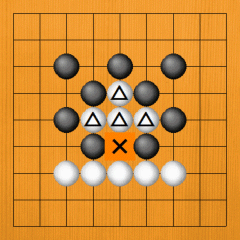
Dia. 37 |
|
Dia. 38 & 39. It's necessary for White to link up with his stones below by playing at 1. |
 |
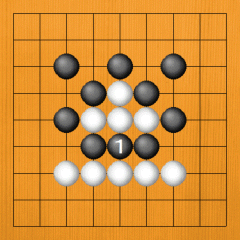
Dia. 38 |
| |
 |
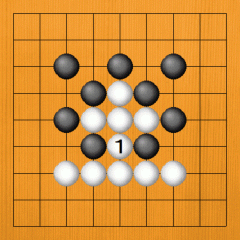
Dia. 39 |
|
· (Application 4) If the shape changes a little, the meaning changes. The white stone on the X point is missing. |
 |
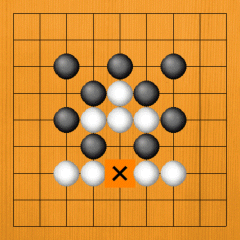
Dia. 40 |
|
Here, too, Black can capture by playing at 1. However, because there's no white stone on the X point --> |
 |
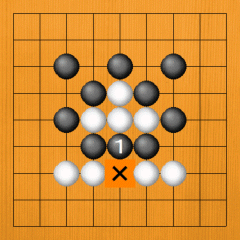
Dia. 41 |
|
Dia. 42. Even if White tries to flee with 1, Black can capture him with 2. That means that Black doesn't have to play a move in Dia. 40, as the white stones are already captured. If you can understand this difference, you will take a big step towards understanding the essence of Go. |
 |
Dia. 42
|
|
Well, then, how about Dia. 43? This time the white stone that was on the X point is missing. |
 |
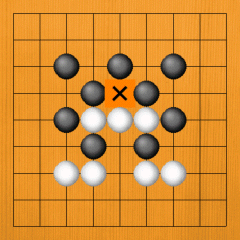
Dia. 43 |
|
Dia. 44. If Black plays at 1, he can capture the three white stones. |
 |
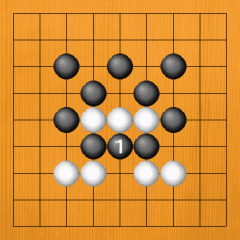
Dia. 44 |
|
Dia. 45. If White plays first, he can link up with 1. Even if Black plays at 2, White connects with 3 and is safe. |
 |
Dia. 45
|
|
Dia. 46. Even if Black plays at 2 here, this black stone is already surrounded in three directions, so White can capture it with 3. The capture enables White to link up. |
 |
Dia. 46
|
(b) Capturing and escaping
· Linking up by capturing an enemy stone is a little high level. There are many clever playing techniques in Go. If an ordinary move doesn't work, then a special technique may solve the problem. These clever moves or technique are called 'tesuji'; they are important, because in a way they are model good moves. If you know many tesuji, this will often give you an advantage over the opponent, so please pay attention when you see the word 'tesuji' in a book. It may be useful to you.
· 'Escaping': moving out one step at a time is one way of escaping, but linking up by capturing an enemy stone is one basic 'tesuji', so it's important to understand this.
· First, please look at Dia. 47. What is the status of the five white stones in the centre? |
 |
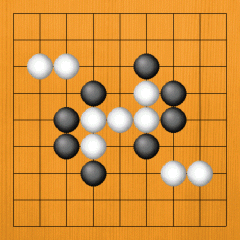
Dia. 47 |
|
Dia. 48. If Black plays at 1, he can capture the five white stones. Trying to escape with 2 is futile: the stones are taken off the board after Black 3. However, Black 1 is not necessary. |
 |
Dia. 48
|
|
Dia. 49. Even if White plays at 1, Black blocks his way out with 2. If he tries to escape below with White 3, Black takes him off the board with 4. |
 |
Dia. 49
|
|
Dia. 50. Even if White plays at the bottom first with 1, it's the same thing. Black 2 prevents him from escaping. If White 3, Black captures with 4. |
 |
Dia. 50
|
|
· (Application 5) When the surrounding position changes, the situation becomes more complicated. In Dia. 51, the marked white stone has been added. Even now, Black can capture the five white stones if he plays first: they can't escape after Black 1. If White 2, Black captures with 3. |
 |
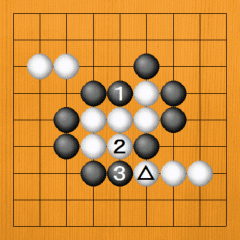
Dia. 51 |
|
However, if White plays first, he can link up with 1 in Dia. 52. If Black 2, White captures a black stone with 3 and links up. It feels good to link up by capturing an enemy stone. |
 |
Dia. 52
|
|
How about Dia. 53? The white stone that was at X has disappeared. How should White play to link up? |
 |
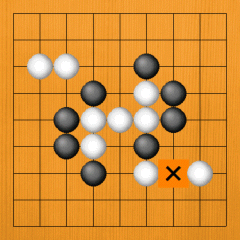
Dia. 53 |
|
Dia. 54. White 1 is still good. If Black 2, White captures a stone and links up. There are also other ways of linking up. |
 |
Dia. 54
|
|
Dia. 55a. White can also link up with 1 and 3, but linking up by capturing an enemy stone as in Dia. 54 is easier to understand. |
 |
Dia. 55a
|
|
 |
 |

 |
|
 |